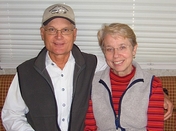Because We Can - Fulltime RV'ing
- Ruthsarian :
- Home :
- Today's Journal :
- Where We Are #2917 :
- Who We Are :
- Contact Us :
Journal Archive 6/1 - 6/10 2009
Scroll down to read the latest post
June 1 Monday
Art and graffiti, Karl Marx Strasse, The Wall, memorial church, victory column,
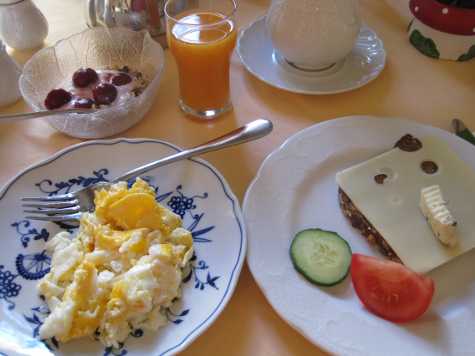
Linda was still having withdrawal pains from those wonderful Turkish breakfast as her plates loaded with what could be a Turkish breakfast, except for the dark bread, shows.
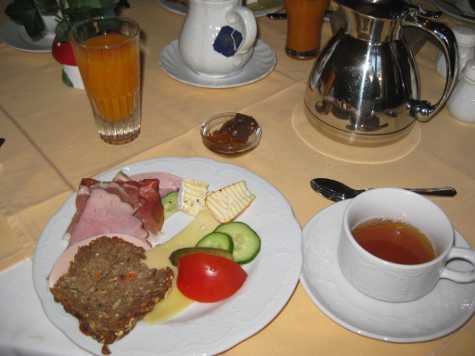
I wasn't having the problems she was, though the cucumbers and tomatoes could qualify as either German or Turkish, with a nod to Turkey. The cured cooked and smoked ham was the best we have had since last years trip to Germany, and I suspect a slice might find its way onto Linda's plate tomorrow.

Walking up the street towards the S-Bahn station, Linda couldn't help stopping to take photos of how the cars were parked. The best in her opinion were the tiny Smart cars, which could park even where there were no parking spots available. It should also be noted that most Germans are big people, not fat, just big, the American argument that those cars are to small wouldn't seem to cut it. Maybe it is more a mental problem than a physical problem.
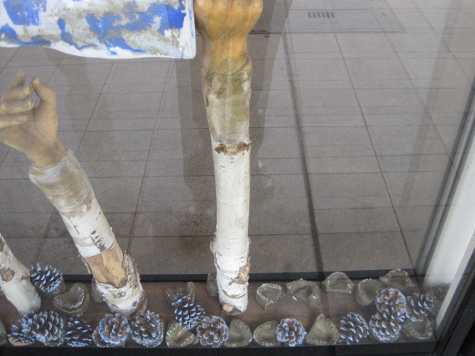
The station has some interesting pieces of art, not the most unusual of which is the bed of pine cones and plaster impressions of teeth, from which is sprouting birch logs topped with hands.
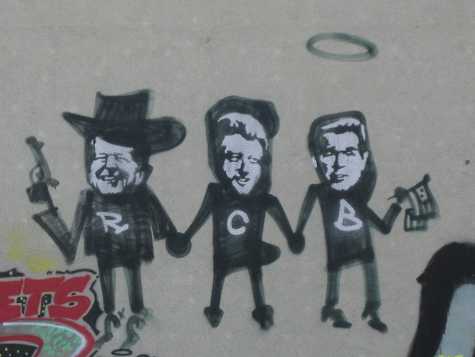
Some will call it graffiti, others art, but what ever it is, my favorite was a drawing of three faces on a building across from one end of the station.R C B, Reagan, Clinton Bush. Not bad I would say.

We wondered where all the people were, then remembered it was a National Holiday, the Monday after Pentecost, which is also a religious holiday.
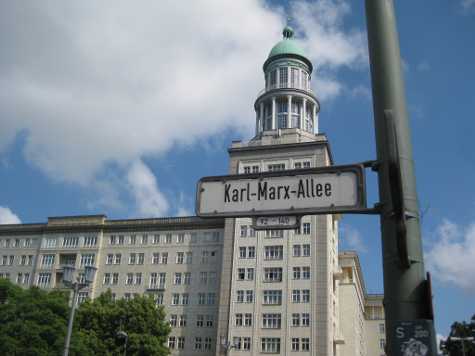
Our destination today was in the former East Berlin, and when we emerged from the U-Bahn station, the street sign certainly reflected where we were.
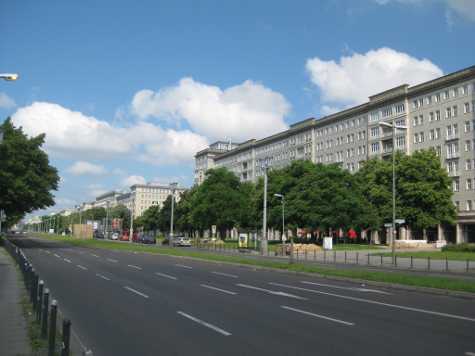
Lining this street, which Joseph Stalin decided would be one meter wider than the famous Champs-Elysees in Paris, are the big, blocky "workers palaces", so popular in Moscow at the time, the early 1950's. To make the street as wide as it was, Stalin ordered that blocks and blocks of buildings be leveled. That's the thing about dictators. What they want, they get.and Stalin wanted a grand street to help celebrate his 70th birthday. How much fun can it be to pick out your own present.

Stalin also had a gigantic statue of himself erected on the street. Unfortunately for him, when he feel out of favor after his death, the symbols of self gratification also fell out of favor. What remains of the statue today is an ear and half of Old Joe's moustache on display in a streetside bar. How far the once mighty and all powerful Stalin has fallen.
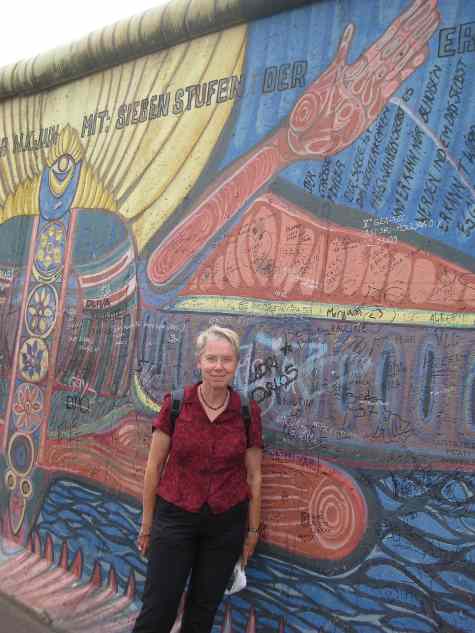
Because of Linda's fascination with the wall, whenever we are near a section, we visit it, which was what we did next. We are getting better at identifying the wall from a distance due to the rolled section at the very top.

Each time we would travel back and forth on the line from the vicinity of our hotel, we would see the remains of this huge steeple. In the afternoon we decided to check it out, something that stunned us with the thoughts that it provoked. It was the Kaiser Wilhelm Memorial Church, the grandest church in Berlin prior to WW II, but Allied bombs turned it into a hulking ruin. Now it silently sends a plea to those that see it that modern war is about indiscriminate destruction, and no person or thing is immune from its deadly effects.
It maybe a case of the victors not learning the same lesson the defeat did, To the victors go the ability to make war in the future as witness our involvement in so many places in the last 60 plus years. To the defeated goes the understanding of what war means when it is brought into your homes, and your entire country is laid waste. Unfortunately stupid people make war and innocent people fight wars,and only stupid people, or brainwashed people, think it is about glory and honor, its about death and destruction.

A small portion of the church had survived, and the mosaics on the ceiling revealed anything we had seen in the churches, cathedrals and mosques of our recent tours.
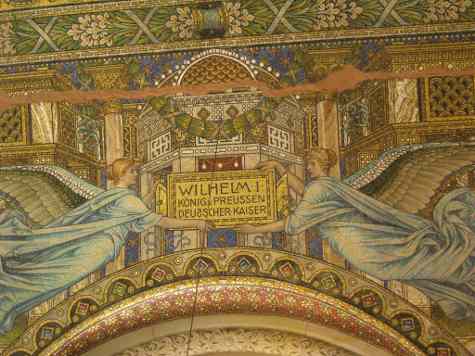
The detail and color of the mosaics was extraordinary.
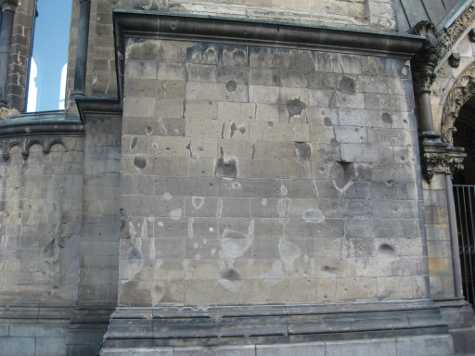
Rather than repair all the damage caused by the bombs and the street fighting, they left it as it much as it was. Next time our politicians want to go to war, lets just lock both sides, only the politicians of course with all of their families, in 3 meter by 3 meter room with a box of grenades in the middle. If they want to fight they can, or if they want to sign a peace agreement they can, it's all up to them. Wonder which option Dick Cheney would have lobbied hard for in that case.

Before the World Wars, German fought and won a few wars. This one commemorated the victories in the wars against Denmark, the 1860's, and France, the 1870's. While the photo doesn't show it, the marble columns are badly chipped from the fighting in WW II. It was while we were here that the sky decided to open up up, so under the cover of umbrellas, we headed for the S-Bahn station and a return to the area where we were staying..
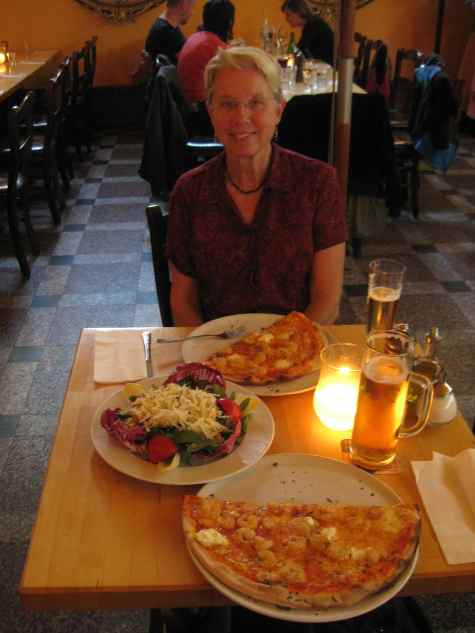
Along the way we stumbled onto a neat little restaurant, and while the rain beat down, we enjoyed a delicious dinner. It had been a gut wrenching day of reflection on the stupidity of man, but it was ending with good thoughts and anticipation of the morrow. Now if we could just take all the lawyers and politicians and shoot them, what a wonderful world it would be. And yes, I'm no better than the worst of them for saying it, but sometimes the ends do justify the means, and this is one of them. And I truly do understand if you don't agree with some, or many of my statements. It's just that being face to face with what took place here has forced me to look at things from a different perspective. All I can be is true to what I feel.
June 2 Tuesday
Missed connections, back to the wall, Soviet memorial, Brass plaque, a picnic for a change.
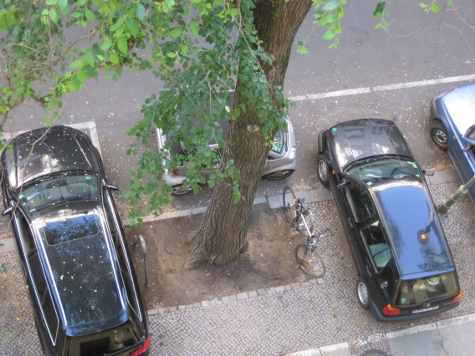
My camera battery was low, so while we ate breakfast, it was charging. Whether Linda was tired of seeing a breakfast photo to start everyday, or just tired, she neglected to take any breakfast photos. I believe that is called giving her the benefit of the doubt. Besides, breakfast this morning was identical to yesterday. The other guests eating when we did were also the people who were there yesterday morning. If it sounds like we are falling in a rut, maybe we are, because even the photos Linda took to start the day were the same as yesterday. Smart cars parked in tiny places, just taken from a different perspective.
With that, we set off for the Zoologischer S-Bahn station, where our morning activity was to start. This was to be a walking tour called, Infamous Third Reich Sites. Starting at 10 AM, you show up at the taxi stand in front of the station if you want to go, pay your money, and a guide takes you around.
We had a bit of a problem however, because even though our plan was to arrive at least 15 minutes early, we didn't make it. The S-Bahn system stopped running, and by the time it was up and going again, we arrived at the station some 10 minutes late, only to find no sign of any tour.

After that experience, Linda wasn't in the best mood, but with what we picked to visit, it got her feeling somewhat better, even if she was blaming me for our missing the tour. As if it was my fault the trains stopped running. The section of the wall we were visiting is part of an exhibit called the Berlin Wall Documentation Center.

Located here is the last surviving complete section of the wall system. The view is towards what was known as East Berlin, during the cold war. From the top there is the inner wall, the barren death strip, and the higher and stronger outer wall, which is the type of wall at all the other locations we have visited.
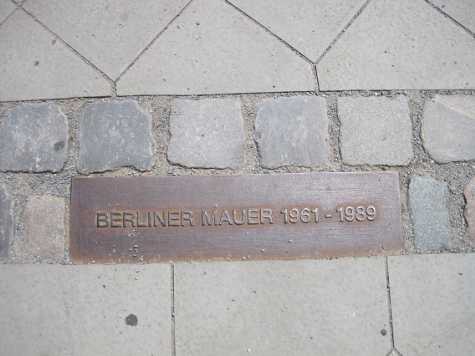
Mauer is German for wall. It also shows the double row of cobbles that marks the location of the wall throughout the city.
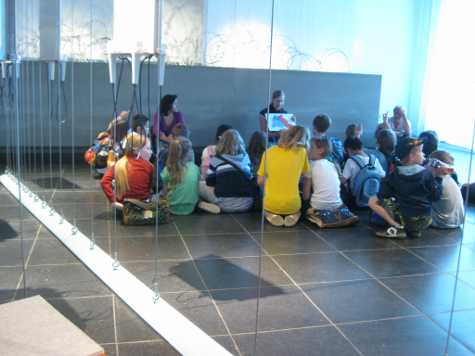
The name of this memorial comes from the fact it documents the history of the wall. Learning this history is an important part of education in Berlin, as witnessed by this group of young students. They were no doubt learning that as time went on the wall was continually being strengthened and improved. Any buildings, whether they be shops, homes, schools or churches that interfered with the wall were torn down. At this site both a church and part of a cemetery were destroyed to make the wall more reliable.
The biggest joke of all was the propaganda the communist government put out to justify the wall. It was to protect the people of East Berlin from the West. The "Workers Paradise" was being threatened, yet East Berlin's citizens who had worked and visited in the West knew different. In a way it reminds me of how our press is always quoting "un-named government sources" in the news reports. They are un-named because what they are telling the reporters is pure propaganda. They may use terms like, off the record, or putting a spin on the news, but it is nothing more than the propaganda we so mocked the communists for using. We do indeed get the government we deserve, it's just that we pay for it with both dollars and lives.
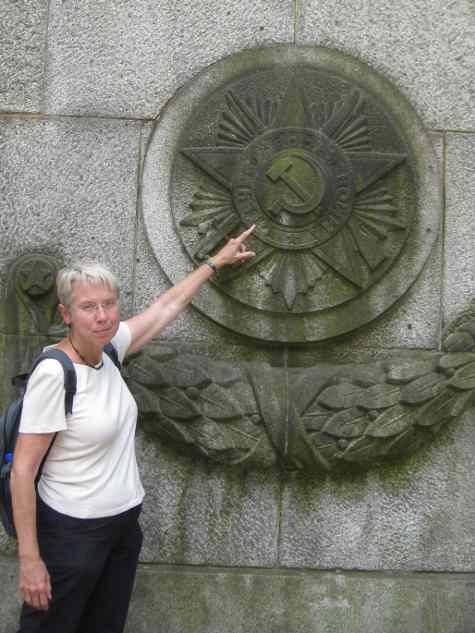
Speaking of communists, that was where we were going next. In 1945, the Soviet Union, read Stalin, had a huge memorial erected which would be our next stop. It turned out to be a long hot, and very crowded S-Bahn ride, followed by an even longer walk though a hot humid park. This was what I wanted to see today, and to say that Linda was unhappy about this would the understatement of the year.
It didn't help that the park itself was beyond gigantic in size, and that other than one small sign near the S-Bahn station indicating the memorial was 850 meters away, there was nothing else showing where it was. Finally Linda said she wasn't gong any further and sat down while I continued searching. Coming back to let here know I had discovered where it most likely was, I'd seen an arch with Russian letters on it, we set out.
It didn't help matter when she realized that the scale that Stalin used to size monuments made our monuments look small in comparison. Lets just say that the walk to it was impressive if you're in to that sort of thing, and infuriating if you're in the mood Linda was in, meaning iIt was many stones throw from the hammer and sickle on the entrance arch, to the monument itself.
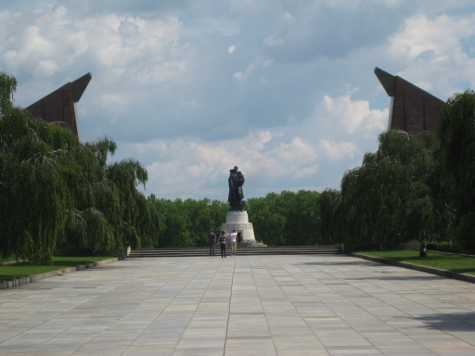
Walking though a woods, we arrived at a point where we could turn 90 degrees and get our first look at the statue. It doesn't look very big, but understand that we were probably still nearly a half mile away from it, and besides, telephoto lenses can do wonders.

About half way there. The memorial had fallen into disrepair, but was refurbished several years ago. does it mean any less that this monument honors those Soviet soldiers who died in the war, if you leave out all the glorification of the communist system.
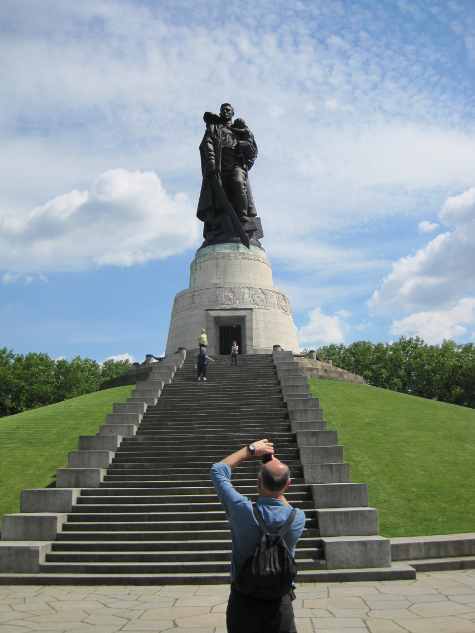
Up near the base of the statue are several people, which gives a better indication of its size.

Symbolism was pretty big with the communists, just as it was in the early catholic churches. The heroic Russian soldier, with sword in one hand, and holding a child in the other, uses his foot to smash a swastika.
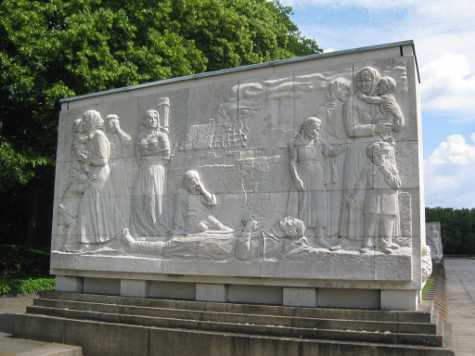
Bordering each side of the memorial as you approach the statue are these stone blocks. On the end of each is an inscription, ones to the left of the statue in Russian, to the right another block with the same carving, but with the inscription in German, which is a quote from Stalin.
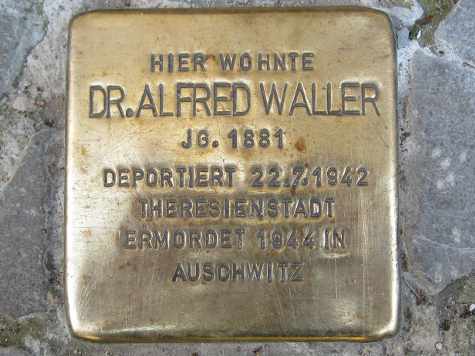
By this time Linda had had more than enough, and it was more than apparent that if we didn't leave, it wasn't going to be pretty in a few more minutes. Then just a few blocks from the hotel we chanced upon another monument. One that poignantly help show just what a buffoon and egomaniac Stalin was.
This small, maybe 3 inches by 5 inches, bronze plaque is one of the thousands of Stolperstine, or stumbling stones found throughout Germany. Placed on front of the former homes of residents who were killed during the war. This simple marker speaks far more eloquently to what war really is than the Stalin's grandiose monument. Dr. Waller, born in 1881, lived here until he was sent to Auschwitz, where he he was murdered in 1944. That is what war is really about, not the glorification of the soldier. After all, it was a soldier, simply obeying orders who murdered him, just as the Russian soldier obeyed orders and raped all the German women. How is it we refuse to look at it from both ways. Oh, that's right, the victors get to put to death the defeated who ordered the bombing of civilians, while the victors call their counterpart, who was actually responsible for far more civilian deaths, a hero. Why wasn't Curtis LeMay every bit the war criminal Goering was, was it simply because we won. I sure don't know the answer, but being in places where you see the results of an unbelievably horrible war up close demands that we think about it.
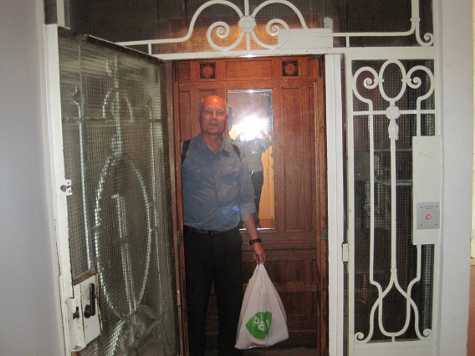
Back at the hotel,Linda was in no mood to climb three flights of stairs, so we used the ancient elevator that evokes memories of the past..

That bag in my hand, was holding our picnic supper, which we ate in the room. By 5 o'clock Linda was was asleep, after saying she wasn't going to do that much walking again. That isn't going to make it easy to do what I want to see, which is the Sachsenhausen concentration camp, some of the Prussian palaces and the wonderful museums of Berlin. All that plus the fact that on Thursday the temperature is predicted to plummet and the rain to fall should make for a very interesting time. As the French say, C'est la vie, or something like that. Man do I ever miss having an Internet connection.
Excuse the wordiness and strong opinions, but I just had to get some things off my mind.
June 3 Wednesday
ARBEIT MACHT FREI

It was another day that the early sunrise saw me already up and writing. I think knowing what we were going to do today was already weighing on my mind. Linda must have had the same emotions because she too was up earlier than usual. Breakfast was the usual, though we hit the yogurt and cereal table harder than the meat cheese platters.
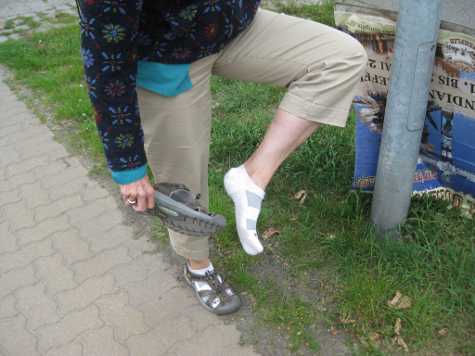
As we walked down the stairs to leave the hotel we could feel that the cold weather, which had been forecast for Thursday, had come in a day early.. It was going to be a cold June day in Berlin, and once we arrived at the S-Bahn station we discovered it was a cold wind tunnel. Fortunately there was no repeat of yesterdays service interruption, and we were soon on our way.
The trip to Oranienburg involved one change of trains and even so, took nearly an hour to arrive in that small town north of the main part of Berlin. From the station we walked the final few kilometers, all the while with Linda having problems with rocks in her shoe. I believe that part of her frustration with the rocks was also the knowledge of what we were about to experience.

An entrance with an iron gate and a simple sign, and with that we entered Sachsenhausen Concentration camp. As we experienced the remains of this hell of earth where no normal rules of humanity had applied to those held here, it is impossible to convey how we felt. Man's inhumanity to man is a hollow phrase here. What follows are photos and brief comments, nothing is in order, it just is.
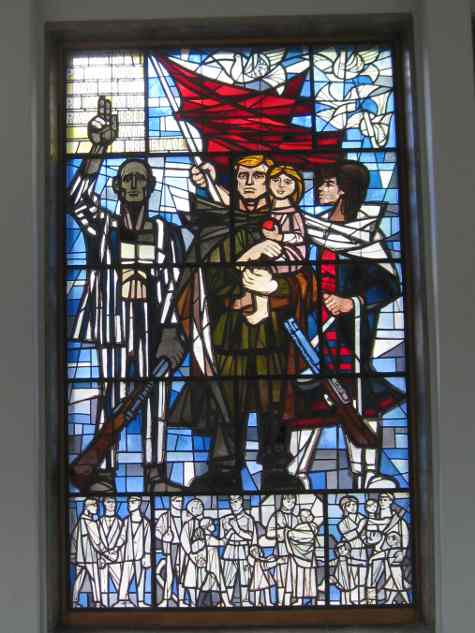
Located in the former East Germany, the communists didn't open the camp as a memorial until the the early 1960's. They couldn't have after the war because then they had turned it into their own concentration camp where they treated their prisoners much the the same way the Nazis had treated theirs,
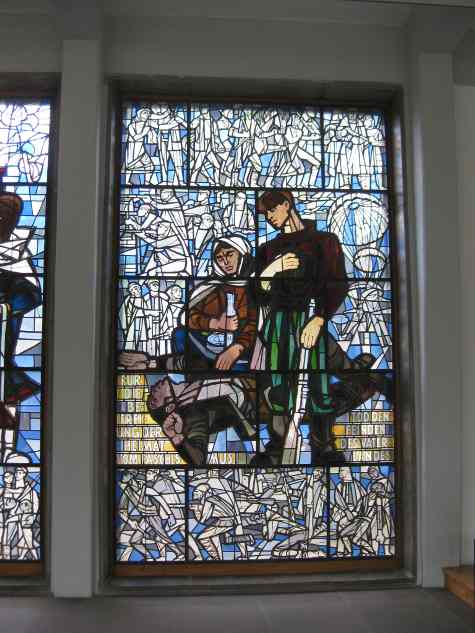
Another window from the communist built museum building. Note that both celebrate the triumph of communism, rather than the horrors of Sachsenhausen. Think of it as the Nazis imprisoning all the communists, then when the communists defeat Germany, they rounded up all the Nazis and imprisoned them. While the communists won the war and America did very little them according to their view of history, the role of Sachsenhausen didn't change. Also, mprison isn't the right word for what the Nazis and communists did to our fellow human beings, but it will have to do.
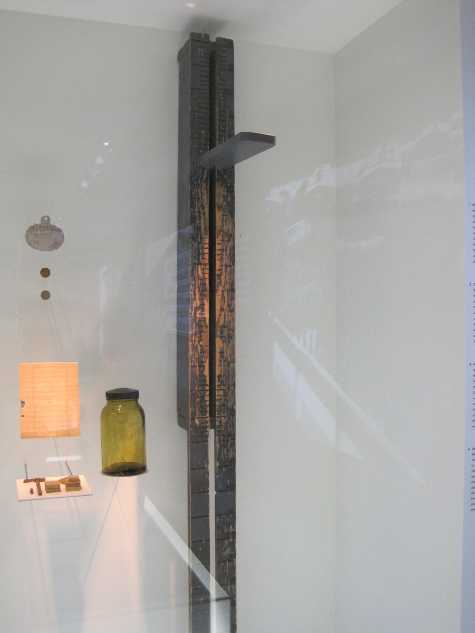
This is a device to measure a persons height, similar to what the doctor uses. That is exactly what this one was used for but with a difference. While you stood with your back to the stick, an SS man murdered you by shooting you in the back of the neck through the slot in the wood. Over 13,000 Russian prisoners of war were murdered this way in Sachsenhausen. As was stated, the normal rules of humanity, or in this case, the rules of war, didn't appliy in Sachsenhausen.
This was not a death camp like Auschwitz II, where the purpose of the facility was solely to murder people. Rather it was a detention and work camp, plus being located in Berlin, it was a main transfer point for prisoners. At the same time, tens of thousands of prisoners were put to death here, while other tens of thousands died of starvation, disease or torture.
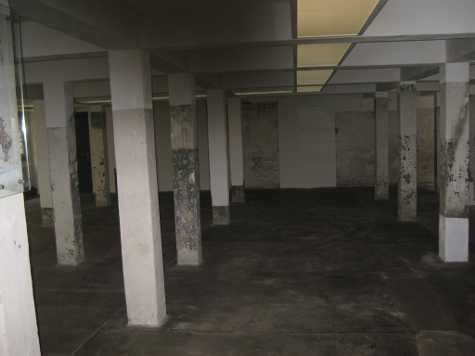
The basement of the camp kitchen where potatoes were peeled. The daily meal was a piece of bread and watery potato soup. The potatoes were often rotten and if you wouldn't eat it, you simply starved to death. It also gave more to eat to those that would eat it.
Didn't peel fast enough, you were beaten. Still not fast enough, your head was held under water in the vats of peeled potatoes. Still not fast enough, your head was held under until you drowned as an example to the other prisoners.
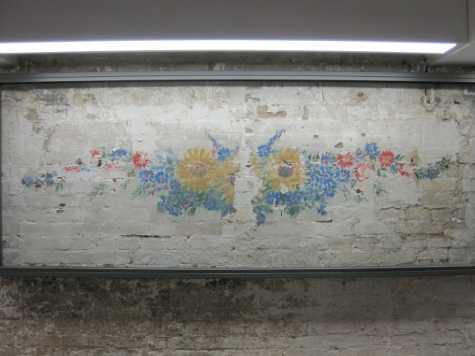
Yet even with all that, the human spirit still prevailed. Here are the remains of a drawing of flowers that was painted on the wall by the prisoners during this time.
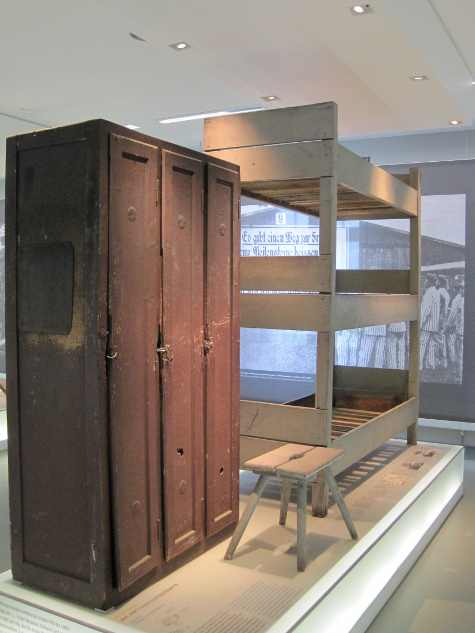
When the camp first opened in the mid 1930's to hold political prisoners, there were lockers for each of the prisoners, who were then grouped three to a bunk unit. Later during the war years, the lockers and stools were gone, and instead of three prisoners to a bunk unit, each with their own bunk, it was three prisoners to a bunk, nine to bunk unit. And there was no rotating of sleep time. For everyone, sleep was from lights out at 9PM to wakeup at 4AM. To make it worse the mattresses were filled with straw which was infested with lice and bugs.
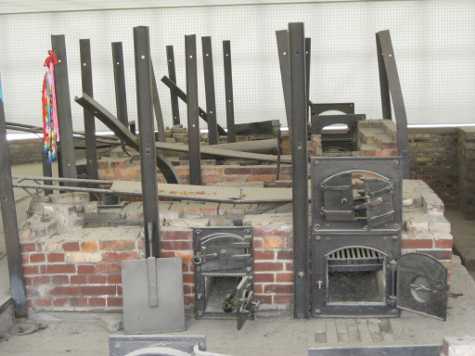
The remains of the ovens where the bodies were burnt. The towns people could smell it in the air. The communists blew it up some years after the war for some unknown reason, as the Nazis SS guards had left everything intact.
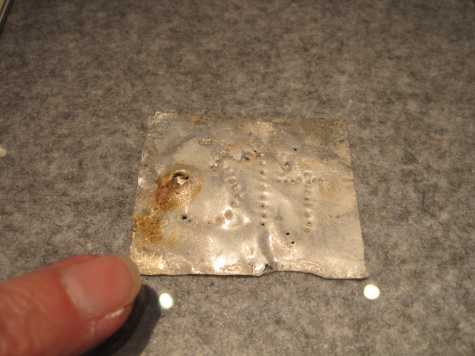
Toe tag used to identify prisoners who died during the time the communists used the camp as a prison.
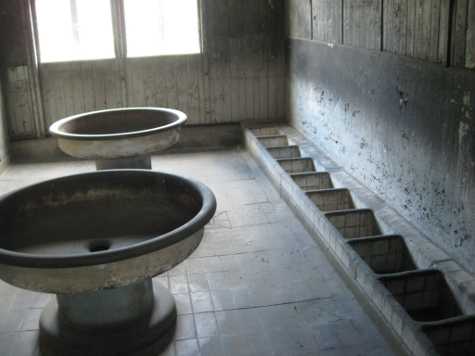
Washroom in a barracks, Too slow to wash, or wash the wrong way, your head would be held under water, sometimes until you drowned for seemingly no reason at all.

A group of women ready to be processed. It didn't matter who you were, if the Government decided you were a risk to it, you went to prison. Nazi or communist, whichever was in power did the same thing.
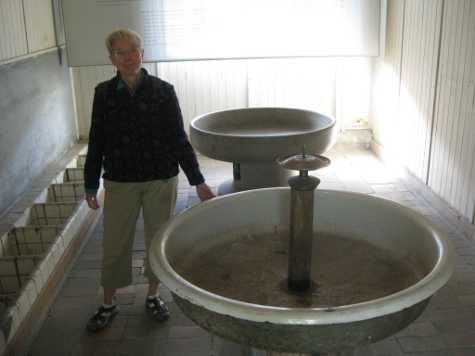
Belong to the wrong ethnic group, associate with the wrong people, read the wrong literature, be in the wrong place at the wrong time. It could have been us standing in the washroom hoping to live another day.
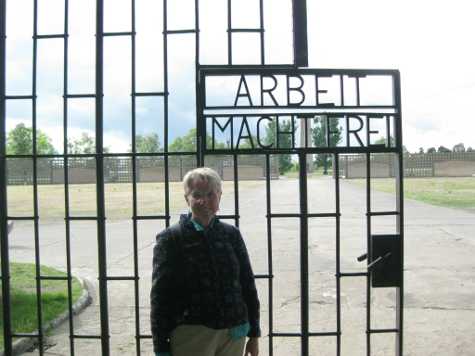
At the end of a long and emotional grueling day, we walked back out through that same gate we entered through this morning. The sun was shining and future was promising. How different from those who, whether under Fascism or communism, entered this same gate where the ends always justified the means.
When I think of how our former Vice President, Mr. Cheney, claims that torture is justified in our war on terror, I wonder how he would feel if the it was him being tortured to confess something he did or didn't do. Oh, that's right, it's us being threatened so it's okay. Tell that to all those souls, wherever they may be who were murdered under the same justification by either the Nazis or the Communists at Sachsenhausen. After all, just as Mr Cheney says, they too said it was justified because their way of life was being threatened. Aren't you proud to be an American with leaders like that. And to end, with Mr Obama keeping the prisons open with the no doubt hollow claim that we won't torture, is he really any better? The experience of travel opens your eyes in ways you can never imagine.
June 4 Thursday
Museum day, enjoying the past, a link with Italy, foot problems
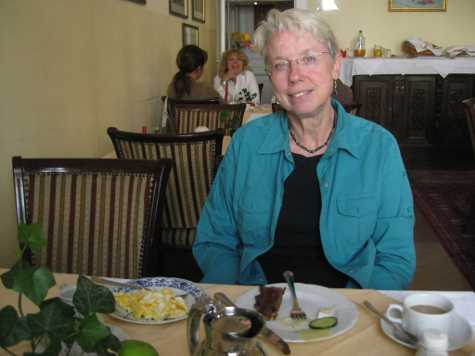
Today we planned for a change of pace, buying museum passes, and taking in some of the outstanding collections of Berlin. Linda was getting fueled up for the day, by downing a scrambled egg with toast, cheese and cucumber slices. Not her usual stateside breakfast, but over here it was exactly what she wanted. I keep telling her she's turning European on me, and darned if she doesn't try to live up to it.
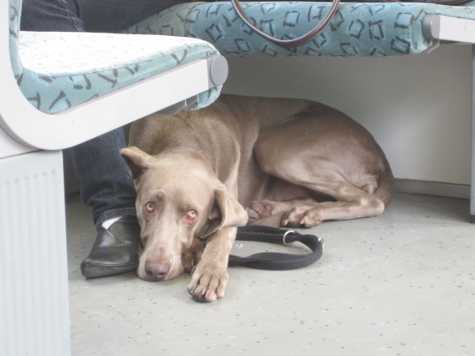
We had an unhappy fellow traveler on the train this morning. She made it very obvious she preferred to sit beside her master, rather than under the seat. It got worse when someone sat in the seat directly across from her. The sigh she let out as she changed positions was loud enough to be heard from one end of the car to the other.
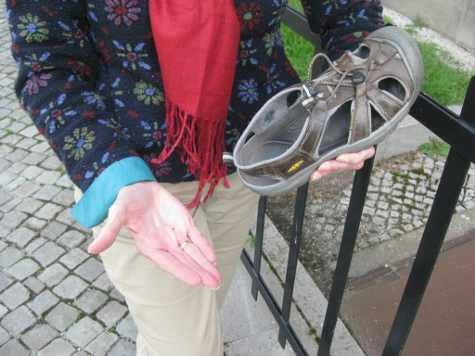
Linda was also an unhappy traveler, picking up these two rocks as we walked to the museum.
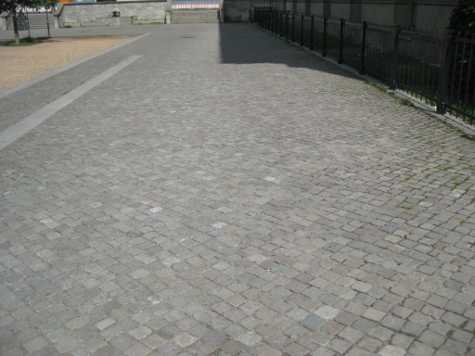
When I looked back, all I could see was a cobblestone pathway. How in the world could she have picked up those rocks from it. I shouldn't have asked, because I got a dissertation on how she had picked the rocks up some time ago and had been trying to move them to a less sensitive part of her foot. My comment about how there wasn't a less sensitive part of her foot sure didn't put me in her good graces.
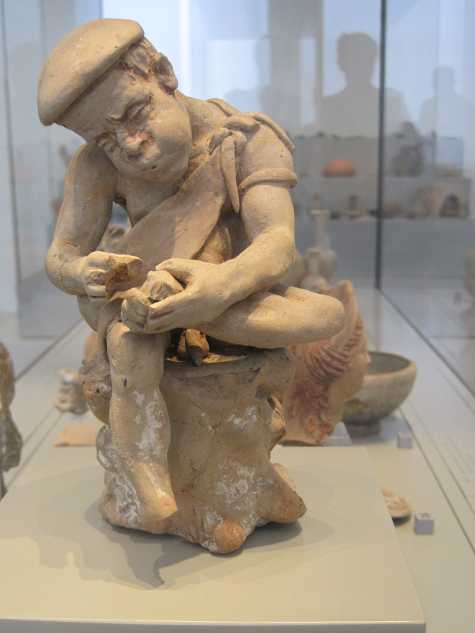
It didn't get any beter once we were in our first museum, which dealt with ancient civilizations. She would have to find this figure of a fellow having foot problems. She was quick to point out that these sort of things were obviously thousands of years old, so hers wasn't anything special and I should stop commenting about them.
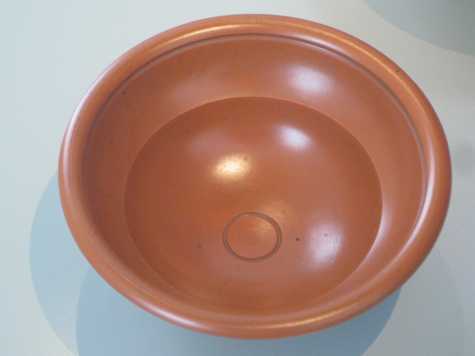
While she was trying to justify her foot problems, I was making discoveries of my own. I love terra cotta pottery, especially pieces which have a satin type of glaze. This piece was a perfect example of what I enjoy.
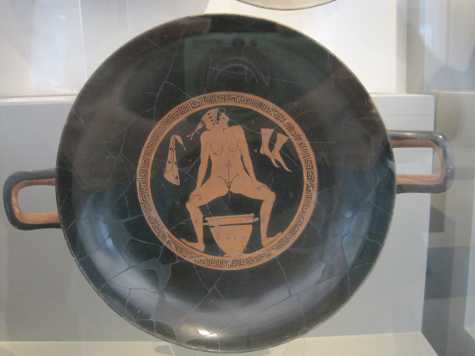
When I downloaded the photos from Linda's camera, I discovered she had found her own style of pottery. Maybe it should be titled, some things never change, the squatty potty is thousands of years old.
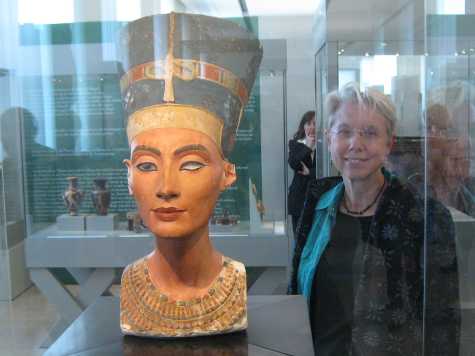
The highlight of this museum is one of the most renowned pieces of art in all of history. This bust of Queen Nefertiti is over 3500 years old, yet it looks like it could have been made yesterday. I note that another beautiful woman found her way into the photo. Two women with long necks in one photo, what a coincidence.

There were also some very interesting mosaics on display. This one was exquisite in terms of its size and detail. The blur at the lower left corner is Linda's finger which gives an idea of the small size of the ceramic pieces making up the mosaic.
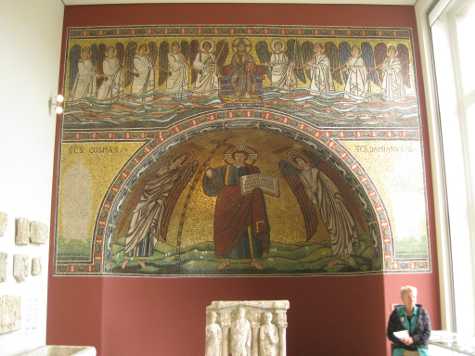
Later, in another museum, we came upon connection after connection with out travels in Italy and Turkey. Take this absolutely gorgeous mosaic which came from a Ravenna, Italy. Now we knew what the type of mosaics we had seen back on April 29th looked like up close, instead of high up on walls and ceilings of those churches and chapels in Ravenna.

Part of the detail of this mosaic. The vivid colors were absolutely stunning, and showed what those high up mosaics in the church in Ravenna only hinted at.
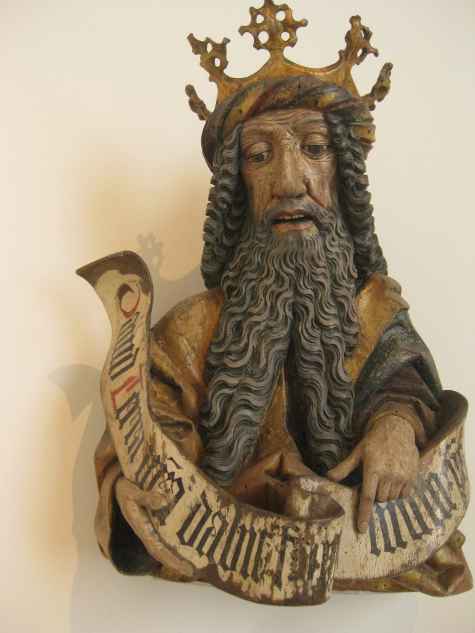
In later times, the woodcarvers art was brought to its highest level in Germany..
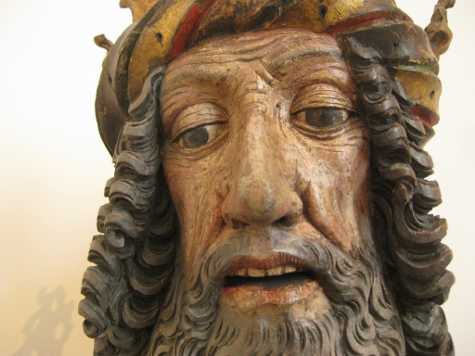
The lines in this face have been carved into the wood, making it truly life-like. Standing there looking at him, you could feel weight of a lifetime which was pressing down on this person and wrinkling his skin.

In the meantime Linda was making discoveries of her own in the footwear department. Here she is once again trying to prove that rocks have always been a problem for people who wear sandals, this time with a marble statue. When I pointed out that I also wear sandals and seldom pick up any rocks, she retorted that I probably did, I just suffered with them so she wouldn't know. Something tells me I'm not going to win this one. It has however allowed us to discover some very interesting pieces of art we wouldn't have noticed otherwise.

Not to let a sleeping dog lay, as we were heading to the exit, she found this small bronze of another woman with the same problem. I've decided that from now on I'll make no more comments about rocks in her shoes. But it isn't going to stop me from taking photos of her taking those rocks out. I'll just keep my mouth shut and let the pictures do the talking.
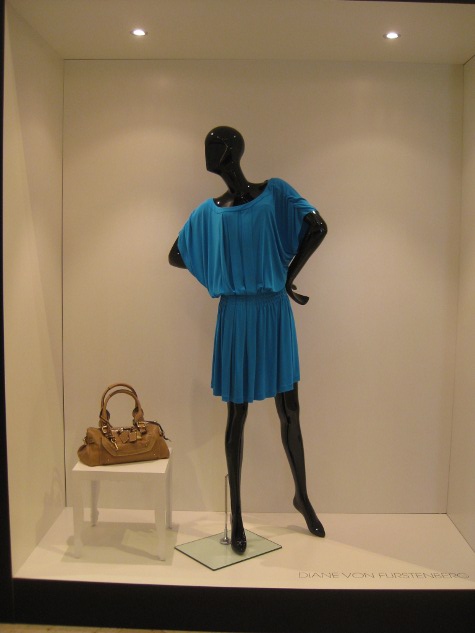
Our last stop of the day was the KaDeWe department store,which claims to be the biggest department store on the continent. We have no idea whether it is or not, because after spending nearly an hour and a half just walking through it, not doing any shopping, we still had half of the store to look at. That was when Linda decided it was time to go back to the hotel.
It had certainly been a different day from yesterday, yet the connections with the past were still there. Throughout our travels in Turkey we had heard about how the German archaeologists had taken so many art objects back to Germany with the blessings of the Ottoman Sultans. today we had seen room after room of those objects, making a connection that brought our travels full circle for the moment.
June 5 Friday
A day of museums

After the rigors of yesterday, it was a morning for food fortification knowing that it takes a great amount of energy to visit museums all day long. Not shown is the heaping plate of scrambled eggs and the bowl of yogurt topped with sour cherries.
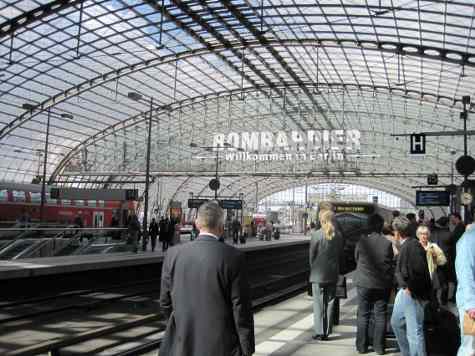
It was another brisk morning as we walked to the S-Bahn station, though we were fortunate that all the rain that had been falling over Central Europe this week had once again missed Berlin. Our first stop was at the Hauptbahnhof, the huge main train station. Built on multiple levels, and with dozens of shops, it is Europe's largest.
We needed to buy our tickets for our trip on Sunday to Warsaw. We ended up with 1st class tickets, which weren't a lot more expensive than 2nd class, because the agent said with a smile, 2nd class in Germany is fine, but in Poland, you will learn to always travel 1st class. Deciding that maybe the experience of learning why we should not travel 2nd class was best skipped on this 6 hour train ride, we paid the 23 extra Euro per ticket for 1st class.
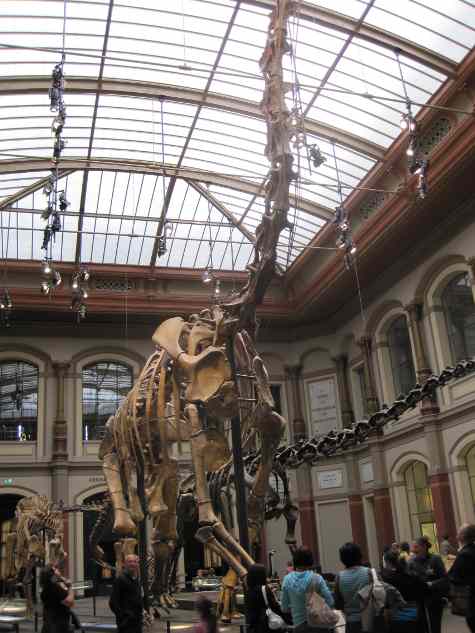
Our first stop was at the natural history museum, in the former East Berlin. It was somewhat out of the main tourist areas, and the area was riddled with graffiti, the streets seemed narrower and the buildings dingy. It just had a totally different feel to it than West Berlin. But once we were inside the museum everything changed. Linda the budding photographer, took a photo of the world's tallest mounted dinosaur. Somehow she forgot to include the feet and the head, but she was trying. Besides she was so excited in this museum, I thought for a second she had reverted to being a little girl.

After having been in several Berlin museums I couldn't help but think back on our tour of Turkey. There they talked about several so called world class museums that were little more that all flash and no substance. In Berlin they don't have to brag about their museums. Just visit one and you know you are in a very special place. The detail on the fish and other aquatic fossils was just amazing.
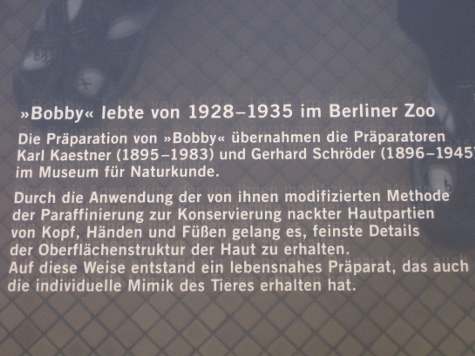
Linda took particular delight in "Bobby", who according to this sign, lived in the Berlin from 1928 to 1935. When he died they used the best means they could to honor him.
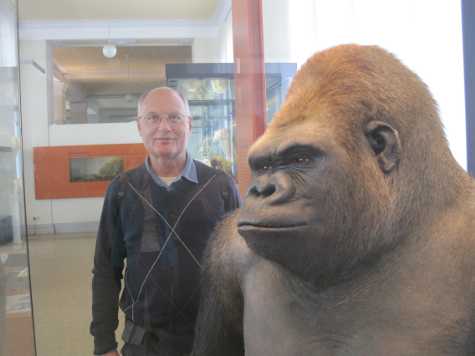
Since Linda has been known on occasion over the years to refer to me as, you big ape, when she was not pleased with my actions, I'm not sure who she thought was who in this photo. Bobby was displayed in the most wonderful exhibit of how the prepare and mount animals for display in the museum, making this a great place to visit the next time you stop in Berlin.

While there are no displays on the second floor, you can climb the beautiful curved iron staircase and look through the windows. This is the storage area where preserved specimens are kept. It is obvious that only the tiniest fraction of the museums holdings are on display.

As we were leaving, I tried my luck at taking a photo of that tall, long necked dinosaur. The result was a photo that had two long necks in it. What a coincidence that one of them resembles that long necked woman who was next to Nefertiti yesterday. Just as pretty too.
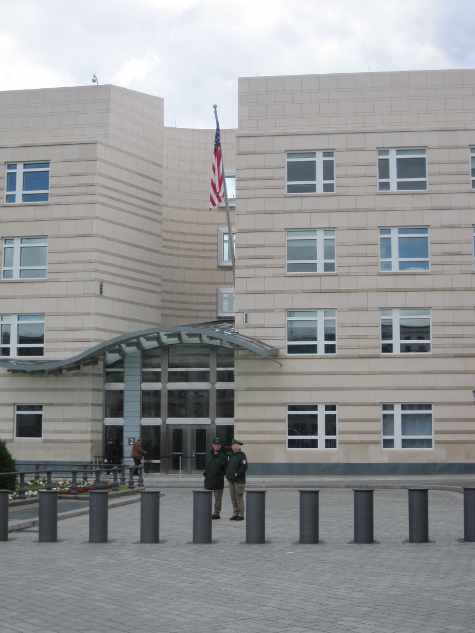
As always, the most heavily guarded building we saw in the city was the American Embassy. Across the street was the French Embassy where the security wasn't even noticeable and you could get right up to the front of it. In a way it reminds me of the King who heavily taxed and controlled every minute of his subjects lives. Deluding himself, he said he needed to live in a heavily fortified castle because his subjects loved him so much they continually wanted to be in his presence.

Another building, a different story. This is the only major Nazi government building which survived the war. Covering a city block, it was the headquarters for the Luftwaffe, or German Air Force. After the war it became the East German Communist government, Ministry of Ministries Building. And you thought government bureaucracy was bad in the US.
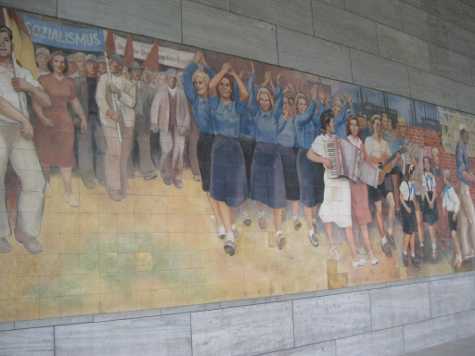
The communists, knowing this was the workers paradise, but unfortunately needing to convince the workers that it was, took the bronze panels depicting military scenes off the walls and put up this mural showing the triumph and glorious life of the East German people under communism. They were trying to repeat the Nazi tactic of tell a big enough lie,and tell it often enough, and the people will believe it. You know, the same thing some radio hosts in our country seem to be doing today.
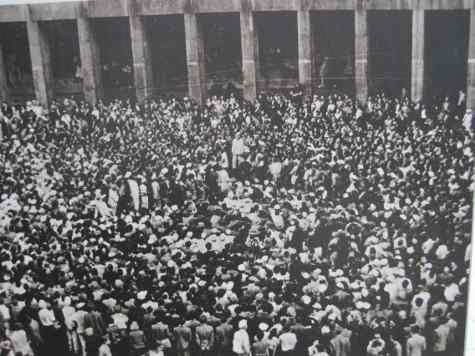
All that propaganda was shown for the lie it was when in front of this building in 1953 the workers staged some mass demonstrations. Only with the most brutal methods and the execution of some of the demonstrators was order restored. In the photo you can see faint parts of that propaganda mural showing through the columns. It took until 1989 to get those freedoms they wanted, but now with the recession and high unemployment, those past days are looking better to some. Some of their politicians want to turn the clock back to the supposed good old days just like some of ours do. No doubt the results would be the same in both cases.
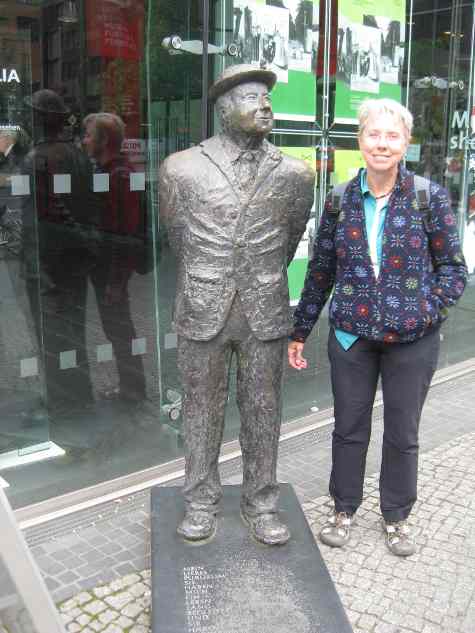
Last year, when we were in the Dutch town of Heerlen, there was an exhibition by an sculptor who did statues of a little man. It involved the placement of statues in different poses at various points around that town. Here was our little old man once again, but this time he was was in bronze and was permanently mounted. These are quite famous in Europe, and we were excited to find one. It's one of those, you gotta know to understand, kind of things.

By this time it was after 2 o'clock, and we were getting hungry, so we decided to head for the Gemaldegalerie and get some lunch in their highly recommended cafeteria before looking at the paintings. We weren't disappointed, as the food turned out to be quite good. Note that Linda made sure her dessert was positioned on my plate for the photo, though I must admit, she did share it with me. I, on the other hand, only allowed her to eat a small bite of my fabulous cooked cabbage. There's going to be some experimenting when we return to the States to try and duplicate its recipe.
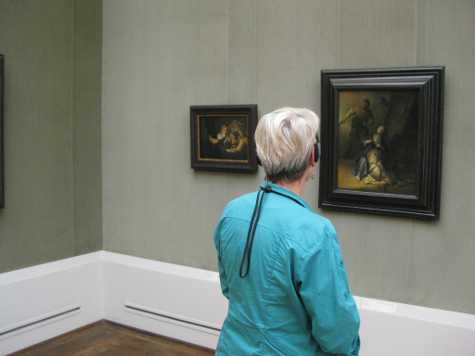
We then proceeded to spend more time in the gallery than both our bodies and minds could take. It was a case of knowing we should leave, but the paintings were so awesome we couldn't. Here's Linda, listening intently to the audio guide, while looking at several Rembrandt's.
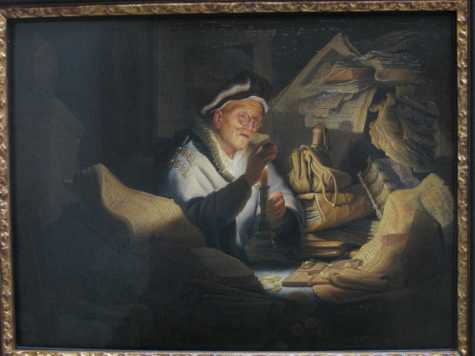
Our photos can do no justice to the real thing, especially with how Rembrandt used light to make the paintings so life like. By the time we were finished, we only viewed a small number of the paintings exhibited, yet saw paintings by,Durer, who Linda really liked, van Eyck, Rubens, van Dyck, Vermeer and Gainsborough. Some our old friends from Italy were also there, Raphael, Titian, Botticelli, and of course, Giotto.
We had definitely overdone it today, but with only 8 days in Berlin, there is simply no way to see even a small part of what is here. The three day museum pass is a great bargain, its just that there is no way to see the nearly 50 museums it gets you into for free. Add to that the inexpensive transit passes, plus all the other sites, and Berlin is a great town to visit. It's easy to see why some Americans we have met in our travels have told us they have been to Berlin numerous times. We know we will be back.
June 6 Saturday
Another world class museum, persecuted people, the persecutors, taking a tour, our last supper
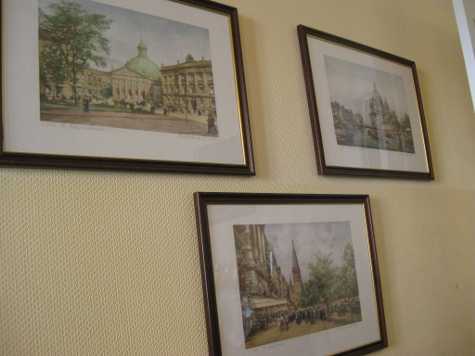
The breakfast room has a number of lithographs of buildings in Berlin. It also gave us the opportunity to visit with a couple from Hamburg. The hotel was full last night, so we were sharing a table this morning. We enjoyed talking with them and learning they often take the very inexpensive flights to Berlin so they can enjoy the museums and other activities. They sounded like us talking, because that's exactly why we are here.
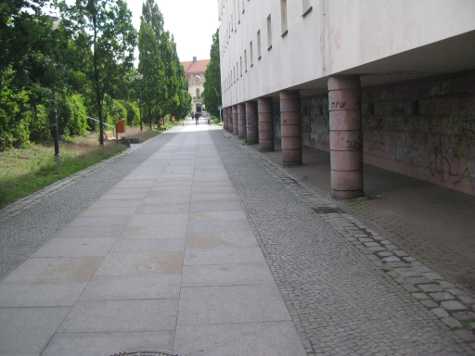
Breakfast over, we were off to the east side of town. We took the S-Bahn, but it was still a lengthy walk from the station to our destination. It took us into what we have found so typical of the former East Berlin. The graffiti on the walls and the overgrown weeds along the walkways. Twenty years after the fall of the wall, the expenditure of billions and billions of Marks and Euros, and there is still a long way to go.
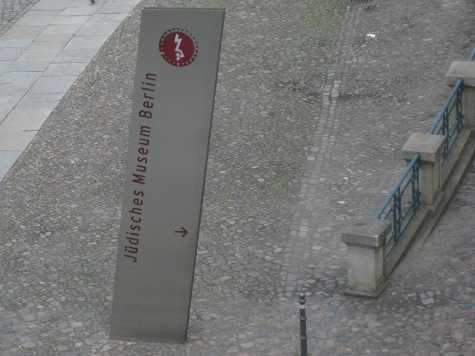
Our destination was what turned out to be another world class museum, the Jewish Museum of Berlin. The building itself is very unique and is a perfect match to the exhibits inside that both celebrate the Jewish life as well as document the struggles and triumphs of the Jewish people throughout history.
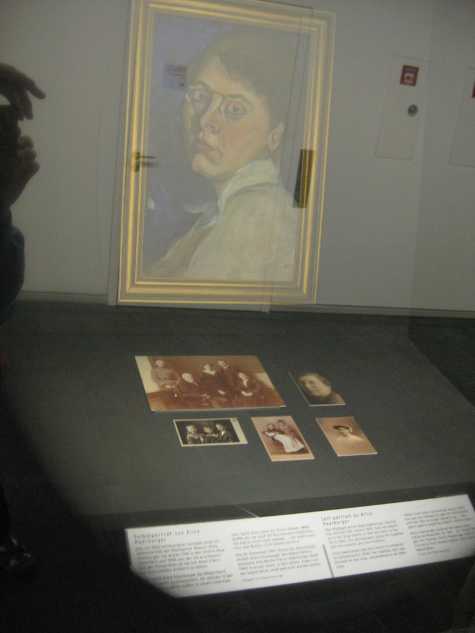
The exhibits did not always lend themselves to photos, particularly those designed as a looking glass back into the past with the glass becoming hazy toward the edges. But they definitely make an impression on anyone who paused and looked at them.
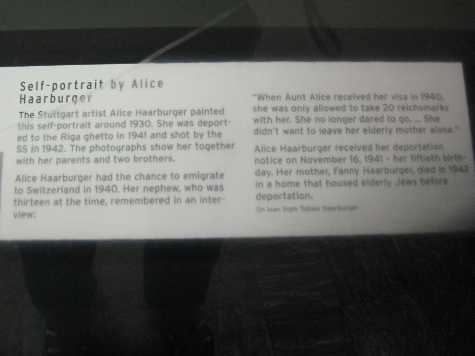
The explanation of the above photo. A self portrait of a woman who was murdered by the SS in 1942. She had received her visa allowing her to leave Germany in 1940, but she didn't go, not wanting to leave her elderly mother alone. If you have trouble reading it, use your browsers view menu to zoom in.

10,000 metal faces. The museum is one of those places where each person gets something different from the experience. You are supposed to walk out on them and let your thoughts wander. I couldn't take it, all I could see were the people, men, women and children, who were one day living a normal life, and the next on their way to an extermination camp where they would be murdered because a government had the desire, power, will and means to do just that.

A bolt of cloth with the yellow star that Jews were required to wear on their clothing. To add insult, they were not given the stars, they were required to buy them.
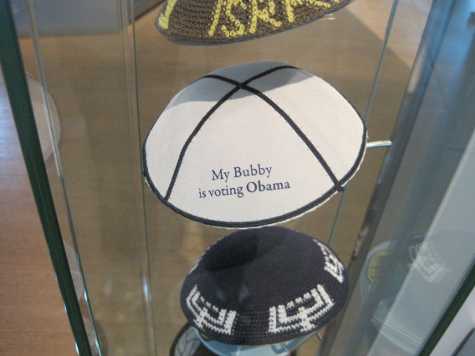
There were far too many aspects to the museum to show it all here. The lives of many great Jewish persons were presented, as well as Jewish daily and religious life. But it was not all serious, like the time Linda got a little chuckle out of this yarmulke.
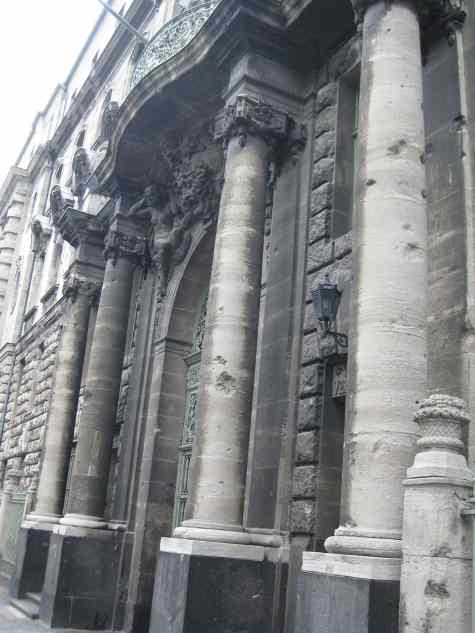
Besides the constant graffiti and weeds, another thing we would often see on our trips into East Berlin were buildings which still showed damage from the war, even though it ended 64 years ago.

This photo was part of the Topography of Terror exhibit in a park where the SS and Gestapo headquarters had been located. It shows Berlin in 1947 and the large open area to the left and above Linda's hand is where those buildeings had been located. As with most of the Nazi government buildings, the communists blew them up after the war, wanting to obliterate any symbols of Facsisim. That mania was even carried to 1961 with the building of The Wall, which they named The anti-Fascist Protective Barrier, trying to associate the West German Government, who opposed communism, as the successor and continuation of the Nazis.

When 2:30 rolled around, I took a walking tour with Original Berlin Walks. It was to the Third Reich sites, lasting four hours and led by a fellow who had a Masters in History, but who unfortunately was a little bit to full of himself. It cost Euro 12, there were 15 people on the tour, and when it was over, he mentioned he did accept tips. The fact everyone walked away without a single person giving him a tip spoke volumes.
It included many of the places Linda and I had been over past week, including the site of the former Gestapo Headquarters where we had visited earlier in the afternoon. A few basement rooms are all that remain, yet it is almost as if you can hear the screams of the victims of Nazi terror.
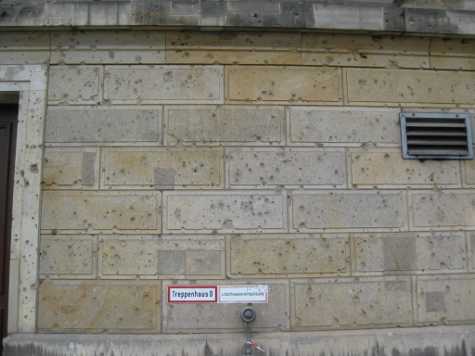
Even though the war was over some 64 years ago, you can still readily see damage on this building which was located next to the former Gestapo Headquarters.
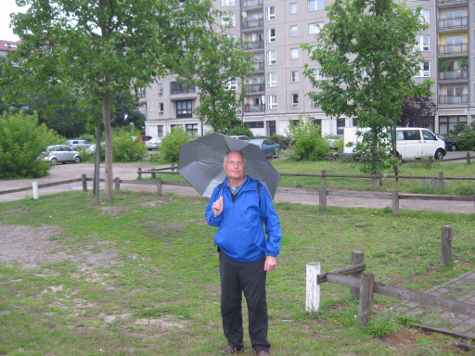
The last stop on the tour was the one everyone had been wondering about, the site of Hitler's bunker. The site is a non descript area near some high rise apartments constructed by the East Germans, the bunker having been crushed and buried. It is also where one of the most demented human beings who ever lived, took his own life rather than face the consequences of his actions which had ultimately resulted in the deaths of 10's of millions of other human beings.

At a nearby U-Bahn station is a mystery. This station is lined with beautiful red marble, instead of the ceramic tiles normally used. The story is that the marble is from the great hall of the Reich Chancellery., the marble having been saved when the communists blew up the building after the war. There are equally persuasive arguments that it did not come from there.
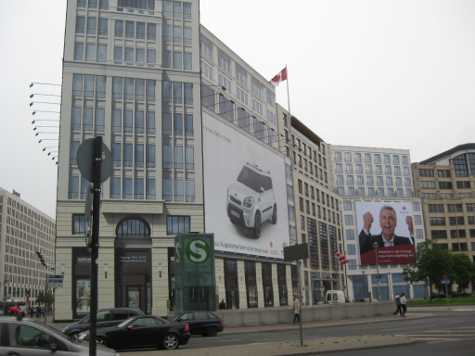
What you see is not always what you see. Potsdamer Platz is the main square in this part of Berlin, and was the busiest intersection in Europe prior to WW II.
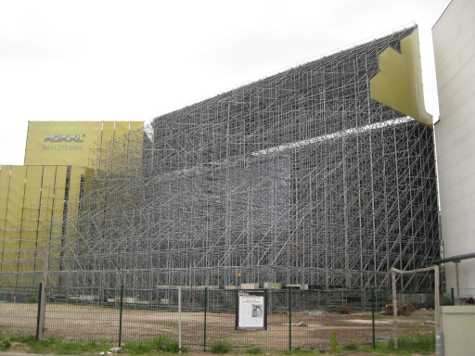
The view from the rear tells a different story. Those buildings are merely scaffolding with a mural of a building stretched across the front. Land confiscated from Jewish owners in the 1930's. What happened to those people. Who owns the land. Lengthy court cases. The legacy of war decades later.

It had been another great day in Berlin, a city we would be sad to leave. Of all the big cities of Europe, Berlin is by far my favorite. With its fantastic transportation network, seemingly endless number of sights and attractions, and the energetic spirit of its people, we know we will return again. The last meal, the Black Forest Chocolate cake, the memories of cooking for a choir retreat at Lake Tahoe, Of Bill and Howard helping us make those same cakes. Connections. Life. We are so lucky. Berlin, we will miss you.
June 7 Sunday
Bye to Berlin, train travel, tram travel, welcome to Warsaw
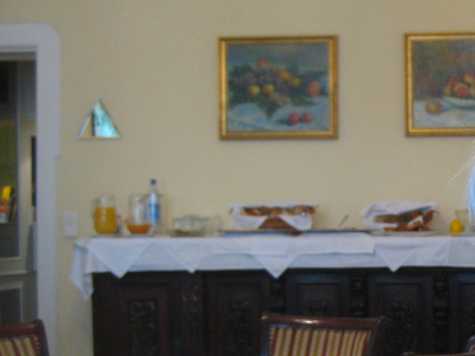
The weekends are usually busy in the types of places where we stay, and this morning was no exception. The difference between staying for a weekend and for 8 nights was noticeable when our hostess came over and asked if wanted our usual coffee, tea and scrambled eggs for breakfast. Sometimes we need a feeling of belonging, and this was one of those moments. It was also our last chance to eat a German breakfast. Unfortunately my ever expanding waistline precluded my partaking of all the possibilities.
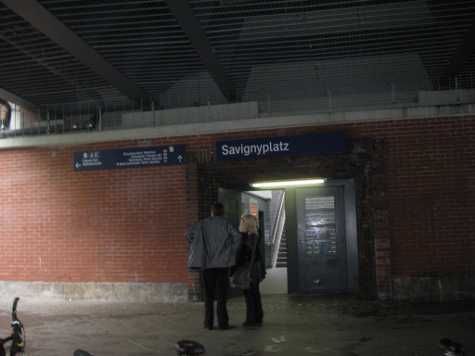
It was just beginning to rain as we made the five minute walk to the Savignyplatz S-bahn station. As we climbed the stairs we noted that the begger with the dog had decided not to come out on this rainy Sunday morning. Then with the usual whooshing sound, the next train arrived and we were on our way to the Hauptbahnhof.
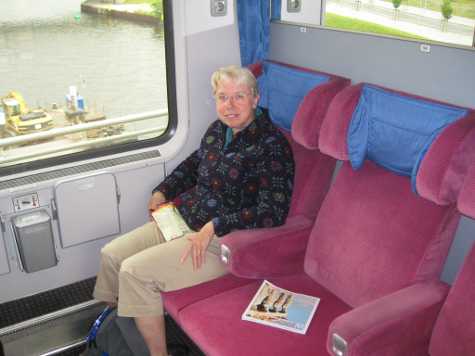
Though we had to wait for over an hour for our train, it was on time, Linda just wanted to be there early, it was worth it because it meant I wasn't going to make us late. It was our initial experience with traveling first class, but it didn't take Linda long to settle in and enjoy our compartment. With seats for six, there was only one other person in with us. Our seats were the two window seats, and Linda immediately made it plain that she needed the forward facing seat. She used the old, I might get sick facing backwards, along with the, you'll probably just read anyway, arguments to get that seat.
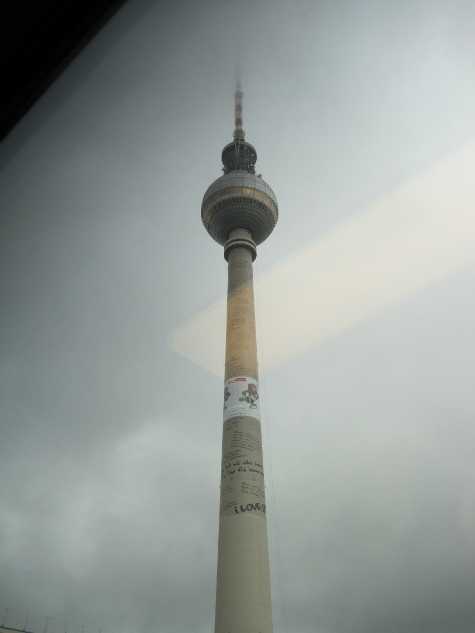
The TV tower told the story of the weather, its top disappearing into the clouds.

So much for her needing the forward facing seat, as this is all she did for most of the trip. Meanwhile, I struggled to look outside, not really seeing anything until it was rushing past. Of course had I not acquiesced to her demands, she probably would have gotten sick. Sometimes there is no reward for being the good guy.
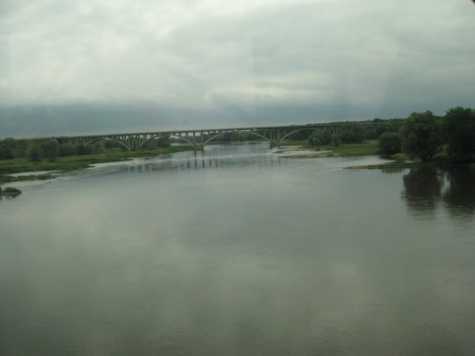
It was also not a short trip, taking almost six hours and nearly a half dozen stops, most of the distance being in Poland. Berlin is fairly close to the Polish border, though that was not always the case. But European countries are not the only ones whose borders are altered by war, look around the world, including our own country's borders for example. They didn't get where they are simply because that's where they always were.
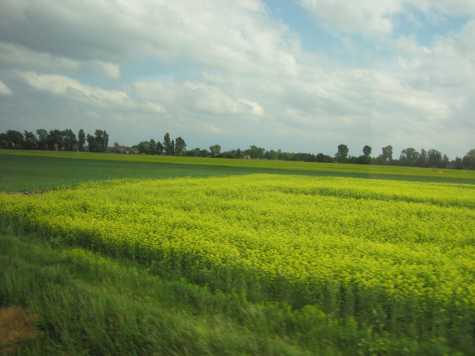
Once we were across the Oder River and into Poland, it was no different than what we had seen elsewhere during our travels, including those yellow fields we had seen in France and Italy.
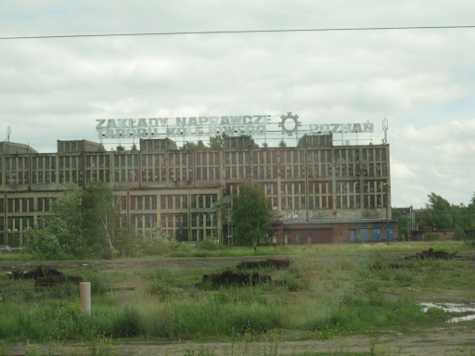
There was one major difference, and it appeared to be a relic of the communist past. Near the towns we would often see giant factories that where obviously abandoned. The free market operates differently than the former communist controlled market of Poland.
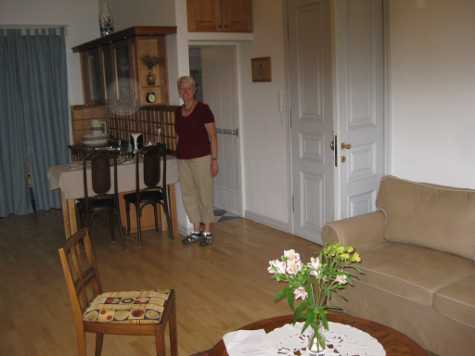
When we arrived in Warsaw, we were most pleasantly surprised by the accommodations we had reserved. We had read about how the price of lodging in Poland was high, while everything else was relatively inexpensive. One look was all it took to convince us that we were certainly getting our monies worth for our lodging. It wasn't a room, it was an apartment that made anything we had stayed in to date look small in comparison.
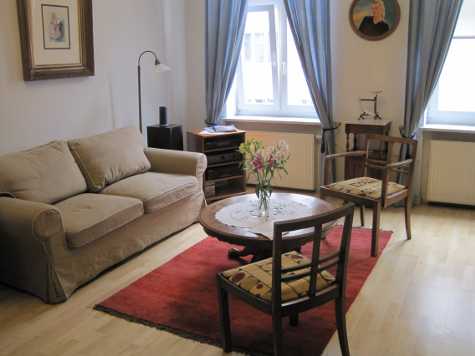
Our arrival in Warsaw had not been without incident however. First was the language problem when we arrived at the train station. Not a sign in English anywhere, but that wasn't the biggest problem. We did find the main arrival hall, get some Zloty's from the ATM, we had to try several machines to find one that would take our card, then bought our tram tickets for the trip to the hotel.
It was at the tram that things got interesting. Linda has this thing about getting out the map long before we ever need it, meaning she has it when we need it. Unfortunately when she looked at it, she didn't pay enough attention to which side of the street the station was on, meaning we got on the tram going the wrong way. That was in addition to her insisting the girl at the info desk had told us any tram would take us to were we wanted to go, something I was positive that was not the case.
Fortunately for her, I quickly realized what had happened, but with there being so many trams and nothing meaning anything, we were in a bit of a problem. So I asked someone waiting at the stop we got offat, how to get back to where we wanted to go. Understand I spoke no Polish, and he spoke no English, but by pointing at the map, and him saying "G"" which was the first letter of the name of the tram we needed to take, we actually got to our hotel. Plus we were still talking to each other when we arrived, a small miracle in itself. We took that as a good omen, and we were looking forward to the next four days in Warsaw.
June 8 Monday
Walking around Warsaw, the horror of war, 20th century Warsaw

We are staying in a bed and breakfast that is renowned for the healthy food it serves for breakfast. They will accommodate any special dietary needs you might have. Since we didn't need anything special we adopted the try everything diet, but quickly discovered it will take several mornings to complete it.
We are less than thee minutes from the tram and bus stops which are near one the city's main intersections, plus there s a tiny neighborhood grocery across the street. With shopping and restaurants, the non-tourist kinds, along the streets It doesn't get much better than this.

When we returned to our room, we learned it was even better than imagined. Our room came with its own laundry person, who immediately washed up all our laundry. What's not to like about Poland. Now if she just stays trained once we return to the States.
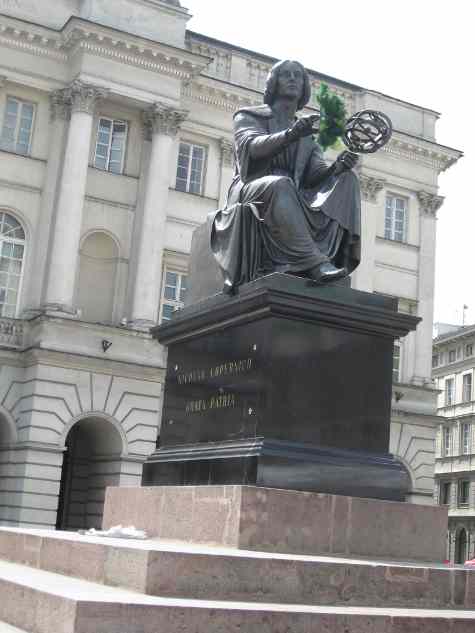
To get acquainted with Warsaw we took a walk, quickly discovering that streets often changed names for seemingly no reason. Another discovery was that one of the all time greats of science was a native of Poland, as this statue of Copernicus proudly showed.
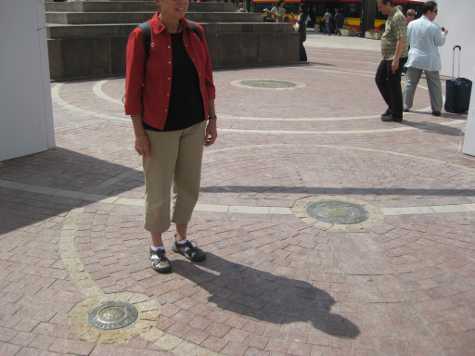
It seems ironic that so profoundly a Catholic country as Poland should so proudly claim the man who destroyed Catholic doctrine by proving the earth was not the center of the universe., but that the planets all revolved around the sun. To prove the point, here is Linda standing between the earth and its moon, near the base of Copernicus' statue.
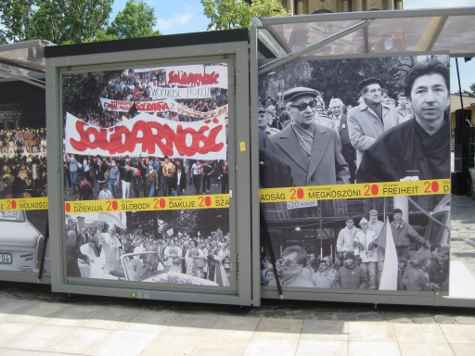
There were also many posters along this street, which ran by the university and toward the old town. They were celebrating the fact that 20 years ago this week the Poles had voted overwhelmingly for Solidarity candidates in the their historic first free electi0n under communist rule.
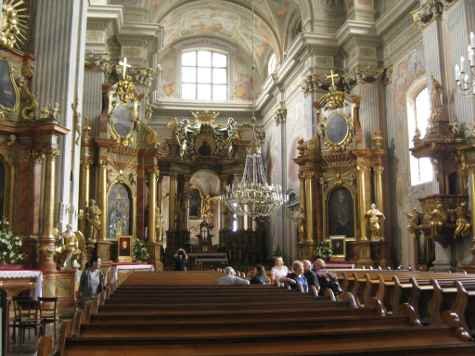
There were also grand and glorious churches, museums and palaces along the street. The only problem was that in many cases they had been rebuilt after the destruction of WW II.
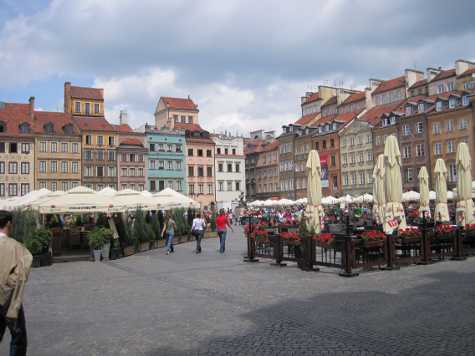
We stopped in the old town square area, thinking it would be a good place to eat lunch. In the end we ate nearby after discovering the prices for the same food a few blocks away was considerably less. It wasn't worth the extra for the view, especially considering that these buildings had been also destroyed during the war and what we were looking at were the rebuilt buildings, the fronts being patterned on the appearance of the square before the war.
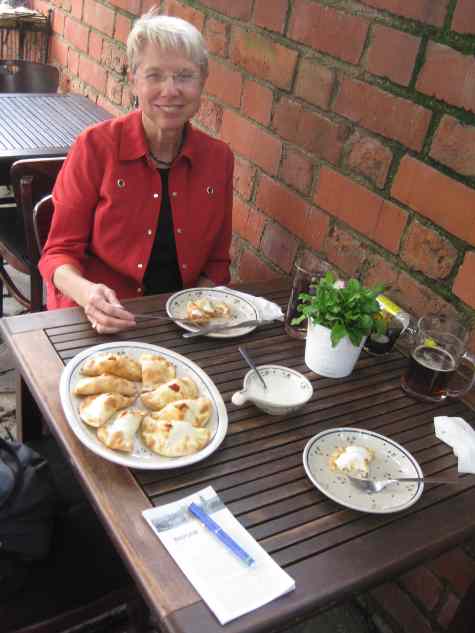
We found a really neat place in the area between the old city walls that had baked pierogi. We ordered a plate that served two with the filling being chicken and mushrooms. Linda decided on the horseradish sauce and was it ever a great choice. The problem is going to be getting the same thing when we get back to the States, or maybe I should say finding a recipe that will result in the same wonderful taste.
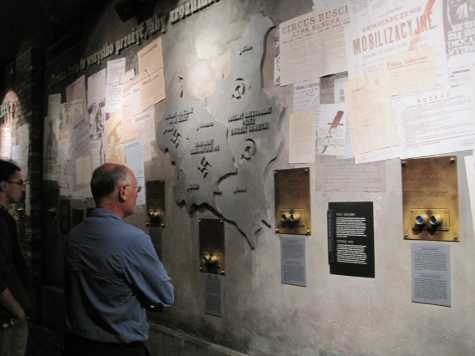
The afternoon was spent at the Warsaw Uprising Museum. This is not the Ghetto uprising, which had taken place when the Jews were being sent to extermination camps, but rather the later one which resulted in the destruction of nearly the entire city. Most people are familiar with the Ghetto uprising of 1943, but just before the Russians arrived in 1944, the Polish Home Army attacked the Germans in Warsaw. By the time the Russians marched into what was left, the ruins of Warsaw were nearly deserted and 2 out every three of its citizens were dead.

As we left the museum, the skyscrapers of modern Warsaw showed the spirit that is the hallmark of Poland. After the destruction of the war, the changes in its borders, the poverty and shortages of the communist years, the new Poland is something to be marveled at. Already we have learned far more about the history of Poland than we ever knew. It looks like it is going to be a very interesting next couple of days.
June 9 Tuesday
Unknown soldier, ghetto, more museums, odds and ends

We decided there was one thing we needed to do today once we had eaten breakfast, get some reservations in Krakow, our next destination. We've found it much easier, plus far less expensive, to use the phone in our hotel rooms rather than a public phone. It turned out to be a good move, because there was a big music festival going on in Krakow and it took three calls to find a room.
That out of the way, we were ready to start the day in earnest. The forecast was calling for rain, but the sky was bright blue when we left the room to walk to the bus stop. Linda had enough walking yesterday, so it was the bus that took us to our first destination.
Except that the bus we took didn't go to where we had planned, but it turned out to be okay in the end, which is what you get when you simply take a bus going in the direction you want to go, the heck with its destination. Which is my thing a lot more than it is Linda's. When I tell her to get a little bit venturesome,she tells me I have enough for both of us.
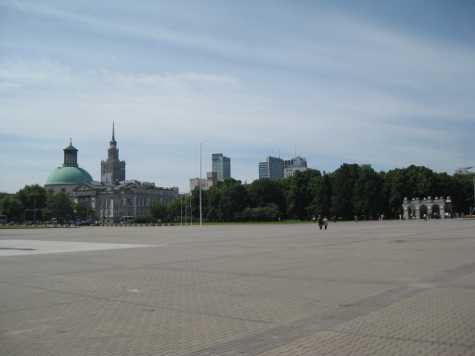
When almost everyone got off the bus when it stopped near this plaza, we decided we would too, because this must be an important place. It turned out that that most of the people were going to the government buildings in the area, but in walking over to the plaza we discovered several things.
Just to the left side of the photo beyond the light colored area sticking out into the plaza, was a giant white cross. This was where Pope John Paul II addressed the people of Poland on his first visit to his homeland after being elected Pope. The large spire is the the Palace of Culture, Stalin's 1955 "gift" to the city, and the symbol of communism. After taking in the view, we walked to the row of arches near the right side of the photo.
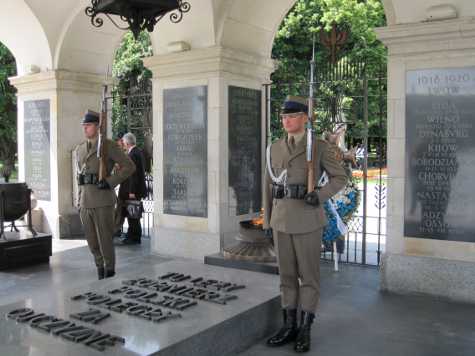
It was the tomb of the unknown Polish soldier. The arches also carried a special significance, with bronze panels on them listing the major battles in which Polish soldiers had participated in over the centuries. Yet that was not all that had special meaning..
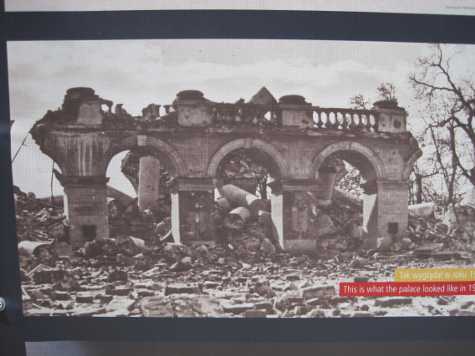
The arches had been part of a grand palace, but during WW II, it was destroyed to the point that these arches were quite literally, the only thing left standing. Rather than rebuild the Palace, the arches had been turned into a fitting memorial.
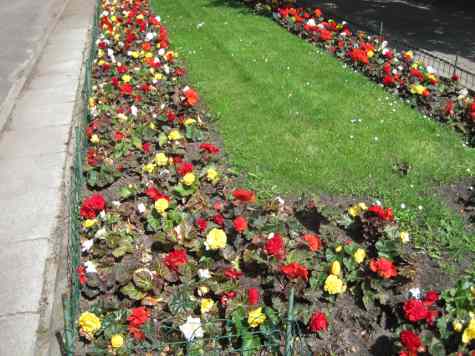
There was a large park behind the memorial, and the contrast between what we had just seen and the flowers in the park was cause for contemplation. For a long time we sat on a bench, just letting our thoughts wander. I couldn't help but think of the song, Long time passing, where have all the young men gone, gone to soldiers everyone. What a horrible waste war is. What if all wars were like the Cold War, more bark, little bite, and when it is over, the world is a changed place.

It is impossible to understand the degree of destruction that occured during the war, both in the Jewish Ghetto, which was literally almost totally leveled, and in in greater Warsaw where 85 per cent of the buildings were destroyed. These few remaining brick ruins bear mute testimony to that destruction.

Modern Warsaw has construction going on everywhere. It also gave me a reminder of my past life, the one where I had to work. They use construction fabrics in Poland, just as we have seen elsewhere during our travels, the lighter colored polyester geotextile being used as a soil separator in this case, and the plastic film being used to minimize water infiltration. More information than you wanted to know, but we all regress at certain moments, and this was one of mine.
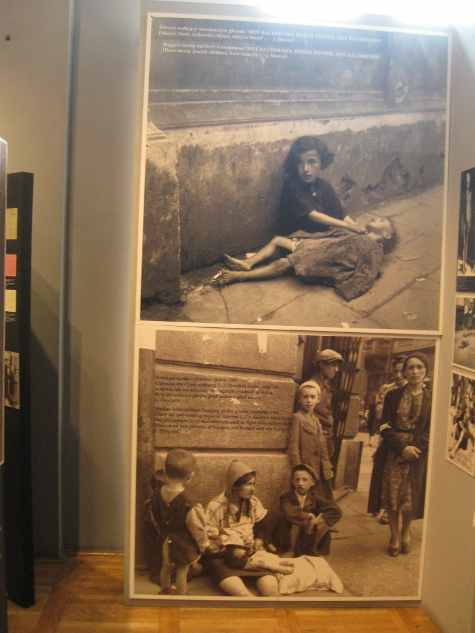
We also visited the museum of the Jewish Ghetto, and while the museum itself left something to be desired, some of the exhibits left you almost in tears. 300,000 people sent off to be murdered in Treblinka. Be very, very glad that someone does not decide that you fall into a class of people that should meet the same fate. Think Cambodia, think Rwanda, think Serbia, but don't think it couldn't happen to us, for all these people thought that very same thought.
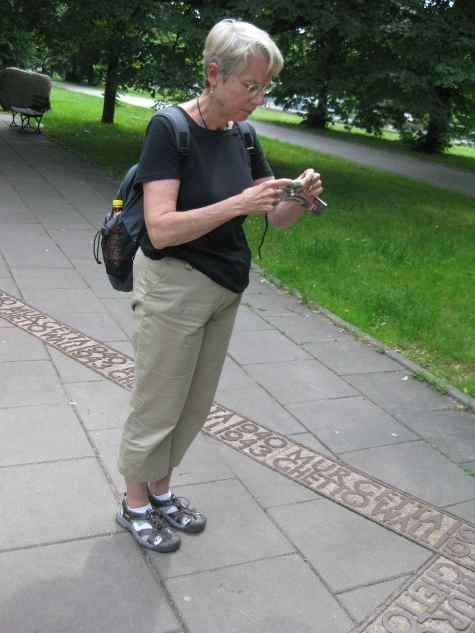
Marking where the Ghetto wall stood. It only existed from 1940 to 1943, because by then the Jews had all been shipped off to extermination camps and the Ghetto had been blown up by the Germans on Hitler and Frank's orders.
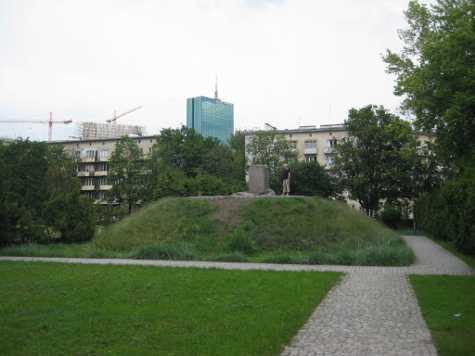
A low mound of dirt marks the location of the headquarters of the resistance. Over one hundred leaders of the resistance movement committed suicide rather than fall into the hands of the Nazis, knowing of the torture before death that surely awaited them should they be taken alive.
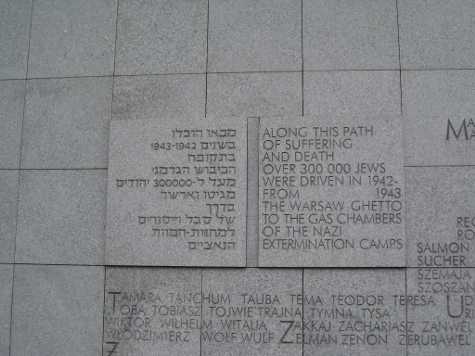
The reason why they chose to fight.

Its something how we make heroes of actors, yet the real heroes, people like the Ghetto or the Warsaw uprising fighters are not only unknown to most people, the fighting itself often is also unknown. In the early 1940's, this wasn't a make believe world where the action stopped when the director yelled, "Cut." It wasn't a world where the good guys always won, and at the end of two hours you could go back to your normal life.
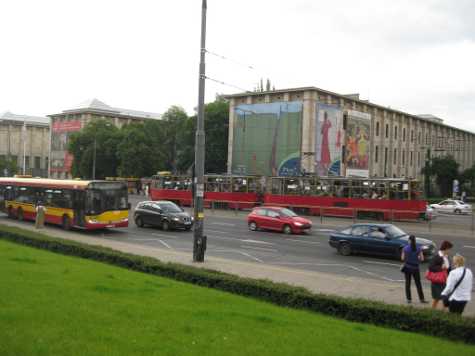
The Warsaw of today is a far cry from those days, yes how different is it. The wide streets, the ever present trams,the people. Poland works hard at making sure the lessons of the past are never repeated, making Warsaw a town that anyone interested in history would enjoy visiting.

Speaking of visiting, while we are traveling we do enjoy checking in on some of the websites we follow as time allows. Normally they are exactly as they are in the States, but sometimes we find a page that is, shall we say, different. Take Grant and Kathy's website, Birding RVers for example. Something tells me they didn't make a special page for Poland, but it looks like Blogger does automatically. The things you discover when you travel, Life, isn't it grand.
June 10 Wednesday
Wandering around town, good food, something for Linda
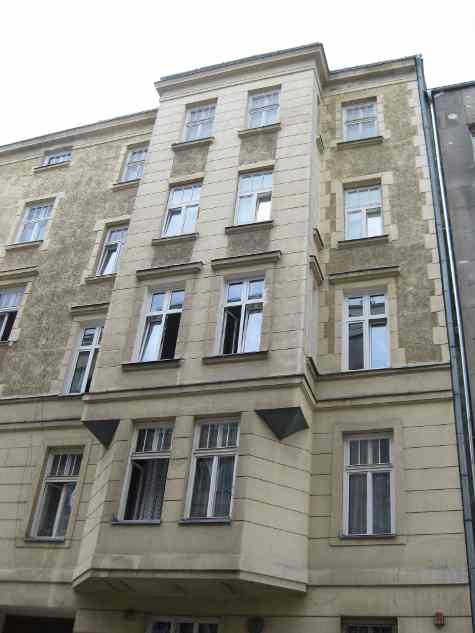
Where we are staying is a bed and breakfast, which is actually an apartment, and our rooms are on the next to top floor. The building is almost one hundred years old, meaning it survived the destruction of WW II. Well part of it survived, since at that time the building had several more floors which were destroyed during the fighting.
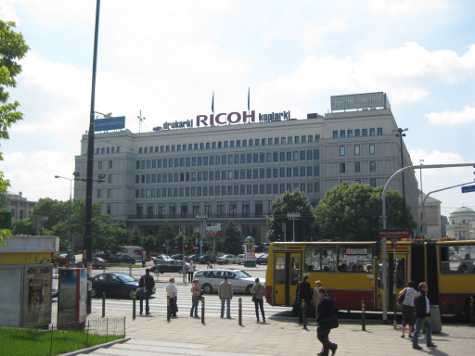
Warsaw is truly a city where everything has a past. Take this nearby building for example. From the modern look and the large Ricoh sign you might think it was an office building. You'd be right, but with only half the story. Prior to 1989 it was the source of power in Poland, for you are looking at the former Communist Party Headquarters building, a building where its former arch enemy, capitalism, now holds sway. Who knows, maybe one of the infinite tortures Stalin is suffering in hell is looking at the current use of this building.
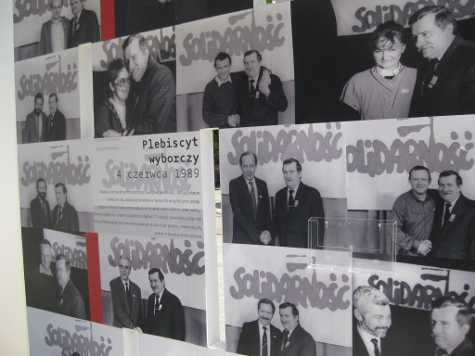
After the war and the brutal repression and purges of Stalin, after the continual shortages and failed uprisings, came the night of June 4th 1989, when by exercising the right of a free vote for the first time, Poland let the world know what people forced to live under communism thought of that form of government. It was a night when not a single Comummist candidate in a contested election district won.
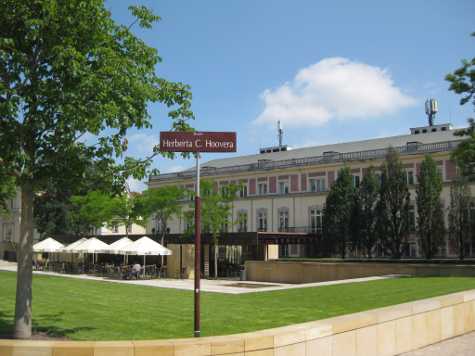
While in the Us, Herbert Hoover may be derided for his role in the Great Depression, in Poland he is celebrated for the help he gave the Poles in the early 1920's, after the end of WW I, and long before he became President.
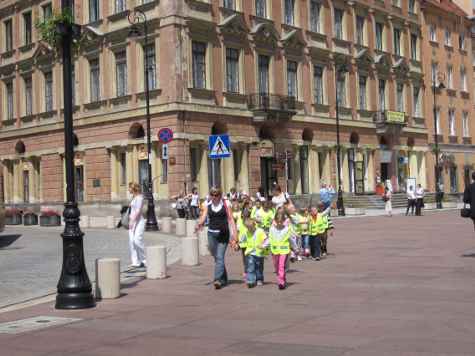
There is a constant stream of school groups at the different sites and monuments. They vary from grade school to high school, and as we learned, this is one country where they really do want each generation to learn the mistakes of the past so they will never be repeated.
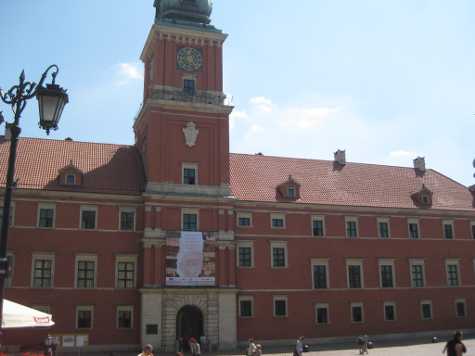
One of the many buildings they visit to help them understand the past.
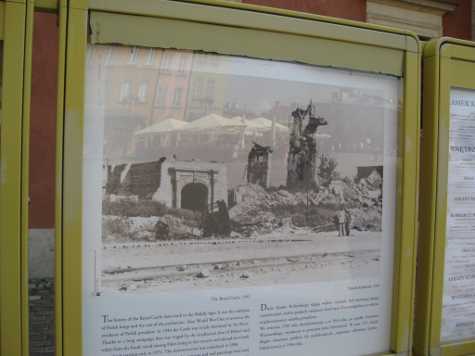
What the building looked like at the end of WW II before it was rebuilt to once again look like it did before the war. Not to demean in any way 9/11, Oklahoma City, the Civil Rights Movement, or the Civil War, but we in America today, truly have no idea of the death and destruction that hatred and war can bring to our country.
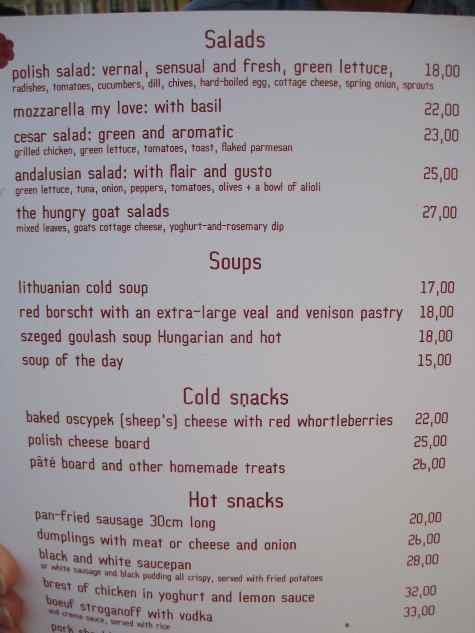
Ending up near the old town square in the early afternoon, we decided to join with the rest of the tourist crowd and eat at one of the cafes on the square. Finding one where the food looked good, my requirement, and the menu was in English, Linda's requirement, we sat down and placed our order. With items like Polish salad, Lithuanian soup and Polish cheese boards to choose from, it was hard to order. I finally settled on Baked Oscypek Cheese with red Whortleberries, while Linda went with that famous old Polish dish, a Caesar Salad. At least she was somewhat happy with it, I on the other hand was totally estatic about mine.
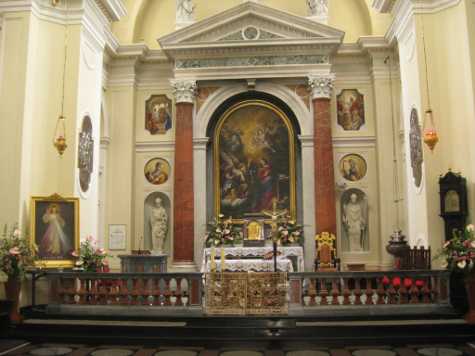
Later, with Linda saying she wasn't walking any more, we got on a bus heading towards where we were staying.Unfortunately for Linda I got into a conversation with a University lecturer sitting beside me. This led to our being many kilometers from where Linda wanted to be, and me having a wonderful time talking about Poland with my seat mate. When we did get off he pointed out several nearby attractions we might want to look at. This church interior proved the point that the churches in Europe are a work of art in themselves.

The cemeteries in Poland are all so neatly kept, with flowers on almost every grave. We learned this was because In Poland people continue to live near the town where they were born, and family is very important. They don't understand how we in America can so easily move thousands of miles away from our families something like a job.
Different culture, different way of life. Whose is better, who's to say, though there does seem to be some regret at the materialism sweeping over Poland, something not everyone welcomes as progress. Now it is work all the time to make more money, with little time for family. The Poles may be soon more like us, than we are like us.
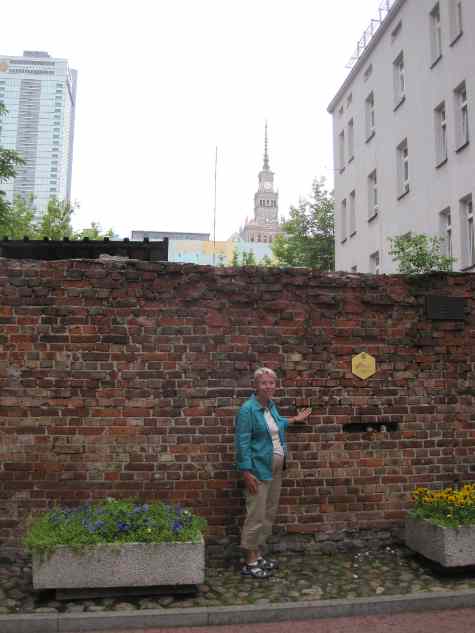
In the early even, with a light drizzle falling, we set off to find the one thing Linda wanted to see that we had missed. It wasn't just see,it was also to touch. To touch the last remaining pieces of the Jewish Ghetto wall. It was not easy finding them, but find them we did.
There are two forms of repression shown in this photo. The Ghetto wall and above it, the top of Stalin's Palace of Culture, the symbol of Communist repression which was responsible for the murder of thousands more of the Polish people. For years the communists denied any atrocities, but when they were overthrown and and freedom prevailed the truth came out. With that, we had seen and done everything in Warsaw we had wanted, and it was time to move on to a place where many were sent, but none ever left.
